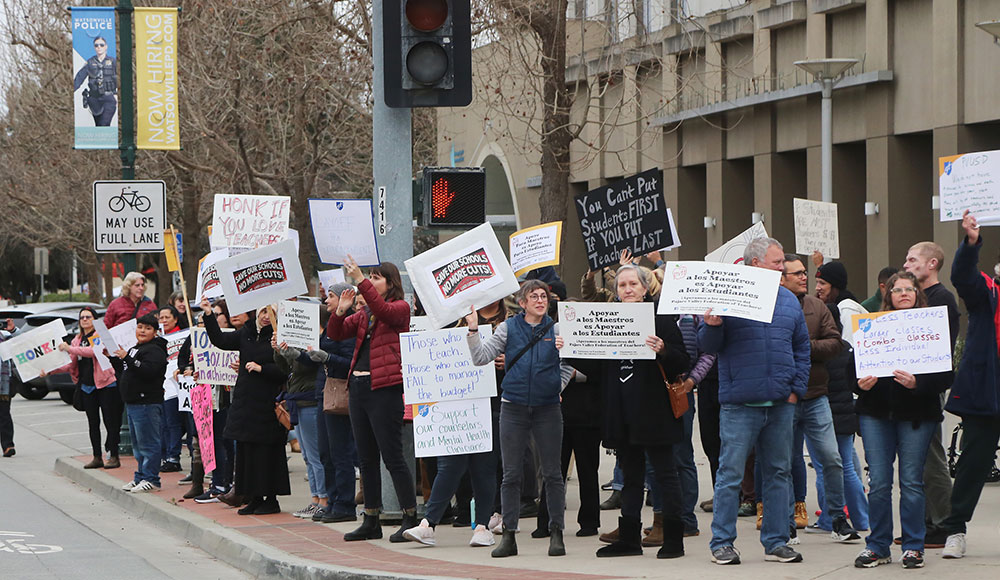This article was produced by Capital & Main. It is published here with permission.
After years of grinding for wage gains that were quickly wiped out by California’s soaring cost of living, unionized educators are about to make a power move.
In the midst of President Donald Trump’s attack on the federal Department of Education and the state’s own struggle with the myriad issues facing its public school system, the teachers’ unions say they’ll coordinate strategies across multiple California districts that together serve more than 1 million students.
Whether they will win better contracts in their individual districts, many of which are fighting ongoing budget issues, is an open question. But some of those who’ve been on the front lines of the education battle in the state feel they have little to lose.
“We have a staffing crisis, and it’s worst in areas where teachers are needed the most. If we want to fully staff our schools, we need a living wage,” said Kyle Weinberg, a special education teacher and president of the 7,000-member San Diego Education Association. “This is why this statewide effort is so critical, and why we in San Diego are all in.”
Under the plan, announced this week by the California Teachers Association, roughly 77,000 educators in 32 districts—about a quarter of the union’s full membership—will bargain for contracts around a shared set of core issues: improved wages, smaller class sizes, fully staffed schools and more resources for students.
The union can’t negotiate for such improvements on a large-scale basis; the individual districts have to do that for themselves. But through a carefully orchestrated series of moves over the past several years, many of the state’s largest districts have aligned their contracts to expire on the same day: June 30.
The hope is that the implications of labor strife at the same time in so many major school districts—San Jose as well as Los Angeles, San Francisco, Oakland, San Jose, Sacramento and San Diego—will ratchet up public pressure and prompt more responsive bargaining in each area.
“I don’t say this lightly: We are facing a crisis in our public schools,” said David Goldberg, president of the California Teachers Association, which represents about 310,000 public education workers. “There are not enough educators on our school campuses.”
During a news conference, Goldberg noted that California ranks in the bottom five in the U.S. for class size ratio and sits at 48th for access to school counselors. A survey of its own members by the union, meanwhile, found that four in 10 are considering leaving the profession—in large measure, they say, because they can’t afford to live near the schools where they work.
The result of such pressures, the union says, is inadequate staffing that can erode the quality of public education. And in a job marketplace in which choosing to become a teacher may mean a struggle to pay for basic needs, California is lagging to keep up. The state has had to figure out ways to fast-track the credentialing process in order to get more teachers into the pipeline, but it still faces a significant shortage.
“The sacrifices that educators are making is significant,” said Lauren Pomrantz, a first-grade teacher and president of the Live Oak Elementary Teachers Association, a 100-member group in Santa Cruz County. “We’re often using our own funds to buy classroom supplies, and the reality is that not one school district in this county pays even the statewide average, even though studies show year after year that Santa Cruz is one of the least affordable places for teachers in the United States.”
This theme of unaffordability is not new; California teachers have been sounding the alarm for years about their incremental wage gains being quickly overwhelmed by runaway housing and living costs. But never before has the statewide union helped coordinate efforts by local districts to both time their contract bargaining and sharpen their message.
The California Teachers Association, which also counts school counselors, psychologists, librarians, support staff and other non-supervisory employees among its members, has often faced battles regarding messaging.
The state’s average salary for public school teachers in 2022-23, for example, was a seemingly robust $95,160, according to the California Department of Education. But that raw number doesn’t account for cost of living, especially housing, in the state’s largest and most expensive metropolitan areas. It also doesn’t reflect the reality that starting salaries for most teachers run in the mid-$50,000s—a tough sell in a place like San Jose.
A recent report by the nonpartisan Center for Economic and Policy Research found that California has been falling behind for decades in teacher pay—and that average weekly salaries have remained flat since 2003, once the cost of living is taken into account.
Over the past 45 years, the inflation-adjusted average weekly wage of California teachers has risen 26.3%, while the average pay of nonteaching college graduates in the state is up 70%. Put simply, people are choosing other jobs. “Both the long-term trends and the recent trends have been troubling,” said Sylvia Allegretto, senior economist at the Center for Economic and Policy Research.
How much school districts have left to give is another question. With declining enrollment a reality, and state funding generally based on average daily attendance, many districts have found themselves strapped for cash and either considering closing schools or actively doing so. Leaders in Oakland have been considering multiple closures to trim a budget deficit estimated at between $75 million and $95 million.
But without adequate teaching staffs, simply keeping schools open won’t solve the issue. And while the California Teachers Association will continue to plead with state legislators to improve funding, Goldberg said, teachers in the local districts will ultimately be fighting many of their own battles.
They’ll now do so as part of a coordinated effort. “They’re able to learn from each other, support each other, and build broader pressure statewide,” Goldberg said. “We have to think of different ways to put students and educators first.”
Copyright CapitalAndMain.com. The California Teachers Association is a donor to Capital & Main.



